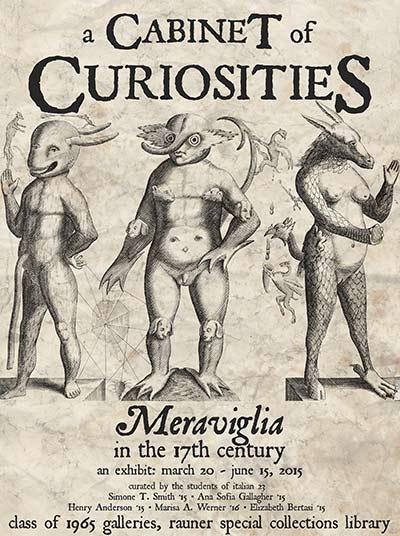In this cabinet, we seek to demonstrate the meraviglia as seen in everyday life during the Baroque. By cataloging the unfamiliar and the wondrous aspects of the New World as well as examining the seemingly banal facets of the quotidian, Baroque contemporaries provided a revolutionary perspective. From intricate atlases to the minutiae of insects, Baroque authors, artists, and philosophers sought to understand the marvels of their surroundings. Their diligent recordings of the everyday afford us the opportunity to gain exposure to and a thorough understanding of their unique experiences and cultural phenomena. Objects seen as embodying both modern and traditional traits are explored in dynamic and unexpected ways. The items in this case illustrate these themes through both text and art.
1. Hessel Gerritsz. Winter, Castle Zuylen (Hyems, Zlot Zuylen), from the Series The Seasons: Views of Castles in the Vicinity of Amsterdam. 1605-1610. Etching. Hood Museum of Art, Hanover, NH.
This etching embodies the way in which daily life was incorporated into art at the time. The scene, one of skaters enjoying a day on a frozen pond in front of a castle, offers a quaint example of how something mundane is transformed into something fascinating, dynamic and unexpected.
2. Wenceslaus Hollar. Plate 1 of 8 from Diversae Insectorum Aligerorum. 1646. Etching. Hood Museum of Art, Hanover, NH.
Even a subject as trite as insects becomes a marvel in this etching. The detail and close study of forms in this collection brings the amazement of everyday minutiae to life.
3. Partenio Tosco. L'eccellenza Della Lingua Napoletana Con La Maggioranza Alla Toscana. N.p.: n.p., 1662. Print. Rauner Rare Book PQ4053.D45 T37 1662
This book, one of the first documented discussions and defenses of the Neapolitan dialect, gives insight into the ways in which even the most basic things, like human language, were thought of in a new and wondrous light. The careful documentation of something as small and fundamental as words gives the reader a sense of awe with which to assess their language.
4. Cesare Vecellio. De Gli Habiti Antichi, Et Moderni Di Diuerse Parti Del Mondo Libri Dve, Fatti Da Cesare Vecellio, & Con Discorsi Da Lui Dichiarati. Con Privilegio. N.p.: n.p., 1590. Print. Rauner Rare Book GT509 .V4 1590
This book, which carefully documents the different clothing traditions and contemporary styles of the 16th century world, is another example of close study transforming everyday items into something sensational. Marvel is found in the everyday, such as the Florentinian women's standard dress seen on this page.
5. Blaeu, Joan. Geographia. Amsterdam: Blaeu, 1662. Volume 1. Rauner Rare Book G1015 .B48 1662 (11 volumes)
Depicted here is a map of the world based on the information known during the 1600’s. It is interesting to note that the map doesn’t simply just provide geographical information, but rather also illustrates the categorical approach that was refined and cultivated during this period.
6. Durante, Castore. Il tesoro della sanita. Veneita: L. Spineda, 1605. Rauner Longevity RA775 .D8 1605
Showcased here is an explanation of how grain should be used, the health benefits of consuming it, and where it can be found geographically. This book functions as a catalog for food, and also underscores the importance of the everyday by demonstrating the true value of grain.
7. Redi, Francesco. Esperienze intorno a diverse cose naturali. Firenze, All’Isenga della Nave, 1671. Rauner Rare Book QL496 .R35 1671 Or view a version of this book online (subscription required).
Pictured here is a sketch of dried vanilla beans, an example of one of the treasures discovered in the New World. In contrast to grain, which is categorized as an object of the everyday, the vanilla is seen as exotic and serves as a representation of modernity.
